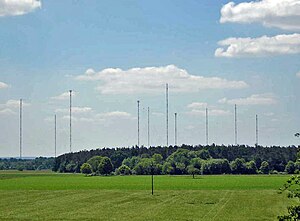|
Standard frequency and time signal service Standard frequency and time signal radio station DCF77 Radiocommunication signal of the time signal transmitter station YVTO Standard frequency and time signal service (short: SFTS) is, according to Article 1.53 of the International Telecommunication Union's (ITU) Radio Regulations (RR),[1] "A radiocommunication service for scientific, technical and other purposes, providing the transmission of specified frequencies, time signals, or both, of stated high precision, intended for general reception". ClassificationIn accordance with ITU Radio Regulations (article 1) variations of this radiocommunication service are classified as follows: In general this radiocommunication service uses radio stations as follows:
Standard frequency and time signal-satellite service GTS-Module onboard ISS, handled by astronaut Vladimir Dezhurov Standard frequency and time signal-satellite service (short: SFTSS) is, according to Article 1.54 of the International Telecommunication Union's (ITU) Radio Regulations (RR),[2] defined as A radiocommunication service using space stations on earth satellites for the same purposes as those of the standard frequency and time signal service. An example to this were experiments of time synchronisation (Global Transmission Services GTS-2) onboard International Space Station. However, in accordance to the ubiquitous availability, GNSS-satellite signals will be used in practice (see also: GPS disciplined oscillator). Frequency allocationThe allocation of radio frequencies is provided according to Article 5 of the ITU Radio Regulations (edition 2012).[3] In order to improve harmonisation in spectrum utilisation, the majority of service-allocations stipulated in this document were incorporated in national Tables of Frequency Allocations and Utilisations which is with-in the responsibility of the appropriate national administration. The allocation might be primary, secondary, exclusive, and shared.
Time signals in useThe following are the known HF time signal stations currently operational.
United StatesThe Standard Time and Frequency Signal (STFS) is a Radiocommunication service providing the transmission of specified frequency and time signal, of stated high precision, intended for general reception in the United States and beyond. The radio signals are broadcast on very precise carrier frequencies by the U.S. Naval Observatory and the National Institute of Standards and Technology (NIST), formerly the National Bureau of Standards (NBS). The technical specification of that particular service is in line to the provisions of the International Telecommunication Union's (ITU) Radio Regulations (RR)[1] See alsoReferences
External links |
||||||||||||||||||||||||||||||||||||||||||||||||||||||||||||||||||||||||||||||||||||||||||||||||||||||||||||||||||||||||||||||||||||||||||||||||